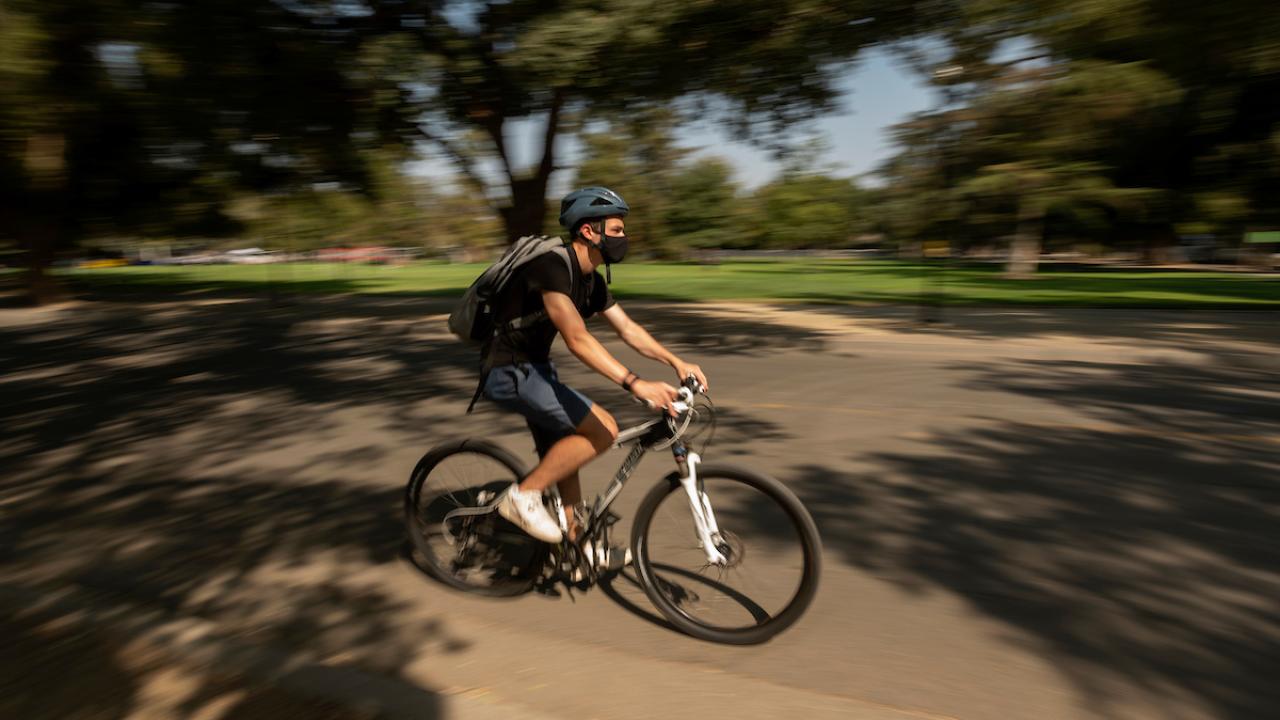
UC Davis Aggie Cycling 101
We've got bike tips to get you rolling!
Quick Summary
- Cycling 101: We lay out basic (and next level) tips for those new to cycling.
- TLDR? Watch a video of "5 Things Every Aggie Cyclist Should Know"
- Dive deeper with Cycling Savvy, a free online bicycle education course on Canvas
Bicycles are a core part of the UC Davis experience and the Bicycle Program is excited to help all Aggies be ready to ride on day one! See what we think you need to know to become a safe and confident cyclist--both on and off campus! TLDR? Skip to the video!
Getting started: Basic cycling tips
- 1. CHOOSE A QUALITY BIKE
We recommend bringing a bicycle from home or purchasing a quality used (or new) bicycle from the on-campus ASUCD Bike Barn. No need to spend excessively ($$$) on something shiny and new (those can attract thieves). It’s better to invest smartly in a dependable bicycle, one that can get you around campus. Upgrades can come later. - 2. REGISTER YOUR BIKE
UC Davis mandates that all bicycles ridden on campus are registered using Bike Index. Registration not only helps manage the volume of bicycles parked on campus, but it discourages theft. Plus, in the event your bike does get stolen, you'll be able to tap into the Bike Index platform and alert users that your bike is missing (that's 1,000s of people also looking out for your bike in secondary markets). Registration stickers are affordable ($12, one-time fee) and help ensure you and your bicycle will stay together until graduation.
Bike Index Registration - 3. LOCK UP YOUR BIKE (PROPERLY)
“I was gone for just a few minutes,” is a well-known cry of a first-time bike theft victim. Any lock is better than no lock. However, we recommend purchasing a quality U-lock to secure both a wheel and a part of the frame to an anchored bike rack. It’s also great to throw in a cable that can be threaded through both the bicycle’s wheels. Together, a U-lock and a cable are a tough locking combination to break through and would-be thieves are more likely to move onto an "easier target". - 4. GETTING AROUND ROUNDABOUTS
UC Davis has many roundabouts/traffic circles on campus. They allow for traffic to continue to flow instead of forcing a 4-way stop, getting everyone to their destinations on time. Please remember that while they help you keep moving, you will need to slow down when entering a roundabout. A few important things to know:- Traffic flows in a counterclockwise direction within the roundabout.
- Traffic (already) in the circle has the right of way.
- Yield to pedestrians when entering a roundabout.
- Roundabouts are meant to slow down the flow of traffic, not stop it. Riding too fast, especially in a busy intersection, can be dangerous.
- 5. WEAR A HELMET (please!)
Helmets are extra insurance to protect you from head injuries in the case of a fall or collision. Really, it's better to wear a helmet and not need it than to not wear a helmet and wish you had. If you're in need, check out our friends at Helmet Hair, Don't Care! They have free helmets and like us, are committed to helping keep you safe.
Click the banner for more information!
Level Up: Have a better, safer cycling experience
- 6. (LEARN HOW TO) PUMP UP YOUR TIRES!
Keeping your tires inflated properly directly affects your cycling experience. Did you know that most bikes on campus are abandoned because the owner doesn't pump up (or know how to pump up) their bike tire? It's easy bike maintenance and taking the time to pump up your tires keeps your bike in good working order and is much more comfortable for you to ride. Some quick tips. to get you started:- Pinch your tire. If your tire has the give when you pinch--somewhere between a tomato and an apple (generally)--your tire has enough air. If your tire is easy to pinch and feels soft like an overly ripe banana (keep with the fruit theme), your tire likely needs air.
- Look for the PSI (pounds per square inch). There should be a number, something like NOT TO EXCEED 120 PSI. When you are pumping up your tires, keep near that range.
- 7. USE A BICYCLE LIGHT WHEN RIDING AT NIGHT (100 lumens or more)
When riding at night or in low light conditions, the name of the game is SEE AND BE SEEN! Bike likes are a must and you are safer from collisions if others can see you. Plus, you want to be able to see where you're going. - 8. KNOW YOUR RIGHTS ON THE ROAD (RIDE RESPONSIBILY)
Understanding your rights as a bicyclist includes; understanding traffic laws, signaling your intentions, knowing where to ride, and how to ride confidently. We offer educational programs in all of the tips listed above. If you're looking for a deeper dive, consider taking the (free) Cycling Savvy Course through Canvas.
Cycling Savvy, Bicycle Education Course - BONUS: UPGRADE QUICK RELEASES WITH LOCKING COMPONENTS
Many bikes have quick-release leavers, which, as the name suggests, are for quickly releasing/removing your tires and seat. You can get those quick releases swapped out for locking components, which make removing your bicycle comments more difficult (and a deterrent for thieves). Consider replacing removable components with locking components. Contact the Bike Barn to learn how they can help.
More of a visual learner? Watch these videos:
Contact us with any questions by phone at 530-752-2453 or email bikeprogram@ucdavis.edu
